| Listing 1 - 10 of 105 | << page >> |
Sort by
|
Book
ISBN: 9780415990646 0415990645 9780415990639 0415990637 9780203927564 9781135853884 9781135853839 9781135853877 1135853878 9786611900021 1281900028 0203927567 9781281900029 6611900020 Year: 2009 Publisher: New York, N.Y. Routledge
Abstract | Keywords | Export | Availability | Bookmark
 Loading...
Loading...Choose an application
- Reference Manager
- EndNote
- RefWorks (Direct export to RefWorks)
In Relentless Progress, Zipes looks at the surprising ways that stories have influenced people within contemporary culture and vice versa. Among the many topics explored here are the dumbing down of books for children, the marketing of childhood, the changing shape of feminist fairy tales, and why American and British children aren't exposed to more non-western fairy tales.
Fiction --- Children's literature. Juvenile literature --- sprookjes --- storytelling --- jeugdliteratuur --- Jeugdliteratuur --- Sprookjes --- Vertellen --- Media --- Verhalen --- Multimedia --- Digitalisering --- Children's literature --- Children --- History and criticism. --- Social aspects. --- Books and reading. --- Books and reading for children --- Reading interests of children --- Juvenile literature --- Literature --- History and criticism --- Social aspects --- Books and reading --- Sprookje --- Verhaal --- Young adultliteratuur --- Vlaanderen --- Vlaams --- Emigratie
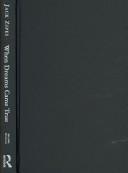
ISBN: 0415980062 9780415980067 0415980070 9780415980074 9780203942246 9781135862169 9781135862206 9781135862213 Year: 2007 Publisher: New York, N.Y. Routledge
Abstract | Keywords | Export | Availability | Bookmark
 Loading...
Loading...Choose an application
- Reference Manager
- EndNote
- RefWorks (Direct export to RefWorks)
For centuries fairy tales have been a powerful mode of passing cultural values onto our children, and for many these stories delight and haunt us from cradle to grave. But how have these stories become so powerful and why? In When Dreams Came True, Jack Zipes explains the social life of the fairy tale, from the sixteenth century on into the twenty-first. Whether exploring Charles Perrault or the Brothers Grimm, Hans Christian Andersen or The Thousand and One Nights, The Happy Prince or Pinocchio, L. Frank Baum or Hermann Hesse, Zipes shows how the authors of our beloved fairy tales used the genre to articulate personal desires, political views, and aesthetic preferences within particular social contexts. Above all, he demonstrates the role that the fairy tale has assumed in the civilizing process—the way it imparts values, norms, and aesthetic taste to children and adults. This second edition of one of Jack Zipes’s best-loved books includes a new preface and two new chapters on J.M. Barrie’s Peter Pan and E.T.A. Hoffman’s The Nutcracker and the Mouse King.
Fiction --- Contes de fées --- Symbolisme dans les contes de fées --- Histoire et critique --- Anthropologie
Book
ISBN: 9780691153384 9780691159553 0691159556 Year: 2013 Publisher: Princeton, N.J. Princeton University Press
Abstract | Keywords | Export | Availability | Bookmark
 Loading...
Loading...Choose an application
- Reference Manager
- EndNote
- RefWorks (Direct export to RefWorks)
If there is one genre that has captured the imagination of people in all walks of life throughout the world, it is the fairy tale. Yet we still have great difficulty understanding how it originated, evolved, and spread--or why so many people cannot resist its appeal, no matter how it changes or what form it takes. In this book, renowned fairy-tale expert Jack Zipes presents a provocative new theory about why fairy tales were created and retold--and why they became such an indelible and infinitely adaptable part of cultures around the world. Drawing on cognitive science, evolutionary theory, anthropology, psychology, literary theory, and other fields, Zipes presents a nuanced argument about how fairy tales originated in ancient oral cultures, how they evolved through the rise of literary culture and print, and how, in our own time, they continue to change through their adaptation in an ever-growing variety of media. In making his case, Zipes considers a wide range of fascinating examples, including fairy tales told, collected, and written by women in the nineteenth century; Catherine Breillat's film adaptation of Perrault's "Bluebeard"; and contemporary fairy-tale drawings, paintings, sculptures, and photographs that critique canonical print versions. While we may never be able to fully explain fairy tales, The Irresistible Fairy Tale provides a powerful theory of how and why they evolved--and why we still use them to make meaning of our lives.
Children's literature. Juvenile literature --- Literary semiotics --- Sociology of literature --- sprookjes --- jeugdliteratuur --- Fairy tales --- History and criticism. --- Social aspects. --- 82-34 --- Fairytales --- Children's stories --- Tales --- 82-34 Sprookje. Legende. Mythe --- Sprookje. Legende. Mythe --- History and criticism --- Social aspects --- Fairy tales.
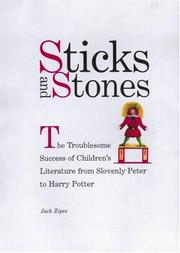
ISBN: 0415928117 Year: 2001 Publisher: New York, N.Y. Routledge
Abstract | Keywords | Export | Availability | Bookmark
 Loading...
Loading...Choose an application
- Reference Manager
- EndNote
- RefWorks (Direct export to RefWorks)
Folklore --- Children's literature. Juvenile literature --- American literature --- sprookjes --- Rowling, J.K. --- anno 1800-1999 --- Children --- Children's literature --- Children's literature, American --- Books and reading --- History and criticism. --- 82-93 --- 82-93 Kinderliteratuur. Jeugdliteratuur --- Kinderliteratuur. Jeugdliteratuur --- History and criticism
Book
ISBN: 2228140503 9782228140508 Year: 1986 Publisher: Paris
Abstract | Keywords | Export | Availability | Bookmark
 Loading...
Loading...Choose an application
- Reference Manager
- EndNote
- RefWorks (Direct export to RefWorks)
Sociology of literature --- Didactic strategies --- Fiction --- Children's literature. Juvenile literature --- Political sociology --- Fairy tales --- Children --- Socialization --- Moral development --- History and criticism --- Books and reading --- Fairy tales - History and criticism --- Children - Books and reading
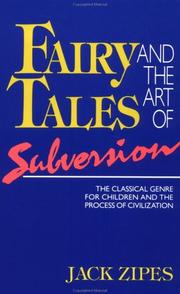
ISBN: 0415905133 Year: 1991 Publisher: New York Routledge
Abstract | Keywords | Export | Availability | Bookmark
 Loading...
Loading...Choose an application
- Reference Manager
- EndNote
- RefWorks (Direct export to RefWorks)
Sociology of literature --- Fiction --- Political sociology --- Child socialization --- Children--Socialization --- Developpement moral --- Enfants--Socialisation --- Ethisch bewustzijn--Ontwikkeling --- Kinderen--Socialisatie --- Lien social --- Liens sociaux --- Moral development --- Moreel bewustzijn--Ontwikkeling --- Sens moral--Développement --- Social bonds --- Sociale banden --- Sociale bindingen --- Sociale samenhang --- Sociale verbanden --- Sociale verbindingen --- Socialisatie --- Socialisation --- Socialization --- Zedelijke ontwikkeling --- Fairy tales --- History and criticism --- Children --- Books and reading --- Contes de fées --- Enfants --- Histoire et critique --- Livres et lecture
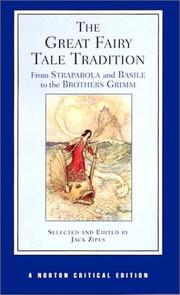
ISBN: 039397636X Year: 2001 Publisher: New York ; London Norton
Abstract | Keywords | Export | Availability | Bookmark
 Loading...
Loading...Choose an application
- Reference Manager
- EndNote
- RefWorks (Direct export to RefWorks)
Contes de fées --- Fairy tales --- Fées [Contes de ] --- Sprookjes --- Tales [Fairy ] --- Fairytales --- Children's stories --- Tales --- History and criticism
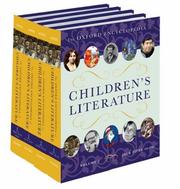
ISBN: 0195146565 9780195146561 0195307629 Year: 2006 Publisher: Oxford Oxford University Press
Abstract | Keywords | Export | Availability | Bookmark
 Loading...
Loading...Choose an application
- Reference Manager
- EndNote
- RefWorks (Direct export to RefWorks)
Children's literature first became a distinct body of writing and publishing in the eighteenth century. Until the seventeenth century, children were usually considered as smaller versions of adults. As the notion of "childhood" as a distinct part of life emerged, a distinct body of literature emerged as well, designed both to entertain and edify this new class of readers. But for much of its history, books written for children were not seen as worthy of scholarly attention. Recently this has changed with everyone from literary critics, to psychologists, to anthropologists, to historians studying this incredibly rich outpouring. The Oxford Encyclopedia of Children's Literature is the first multi-volume set to document and interpret the books read by children in the English-speaking world. It includes brief biographies of every major author and illustrator, and features essays on all genres of children's literature, individual works, and prominent trends and themes, as well as general essays on the traditions of children's literature in many countries of the world. The Oxford Encyclopedia of Children's Literature is available in print and as an e-reference text from Oxford's Digital Reference Shelf.
Thematology --- Children's literature. Juvenile literature --- Children's literature --- 82 <031> --- 82-93 <031> --- 82-93 <031> Kinderliteratuur. Jeugdliteratuur--Encyclopedieën. Lexica --- Kinderliteratuur. Jeugdliteratuur--Encyclopedieën. Lexica --- 82 <031> Literatuur. Algemene literatuurwetenschap--Encyclopedieën. Lexica --- Literatuur. Algemene literatuurwetenschap--Encyclopedieën. Lexica --- Juvenile literature --- Literature --- Littérature pour la jeunesse --- Encyclopédies
Book
ISBN: 0415907195 Year: 1992 Publisher: New York Routledge
Abstract | Keywords | Export | Availability | Bookmark
 Loading...
Loading...Choose an application
- Reference Manager
- EndNote
- RefWorks (Direct export to RefWorks)
Fairy tales --- History and criticism --- Tales --- Tales - History and criticism.
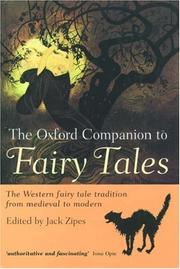
ISBN: 0198601158 0198605099 0191727407 Year: 2000 Publisher: Oxford Oxford University Press
Abstract | Keywords | Export | Availability | Bookmark
 Loading...
Loading...Choose an application
- Reference Manager
- EndNote
- RefWorks (Direct export to RefWorks)
Where do fairy tales come from? Why do we find them so enchanting? What is it about them that is so magical? From its origins in the oral tradition to the modern methods of storytelling through film and television, the fairy tale has always had a powerful grip over the cultural imagination of the Western world. Under the editorial guidance of Jack Zipes, 67 expert contributors have come together to combine their insight and expertise on all aspects of the fairy tale tradition. The result is a unique synthesis of knowledge making this the most authoritative and wide-ranging reference work on the study of the Western fairy tale available. To what extent was Enid Blyton inspired by fairy tales, reading 'every single old myth and legend I could get hold of'? What influence has Walt Disney had on the modern perception of certain classic fairy tales? Where did the Moomins come from? Under what title was Alice in Wonderland first published? In what different ways have fairy tales been portrayed on film? To what extent was the story of Hansel and Gretel auto-biographical? Why has Irish folklore had such a big influence on American film and stage? What inspired Edward Elgar to put fairy tales to music? What is the difference between science fiction and fairy tales? What are the philosophical overtones in 'The Little Mermaid'? Who supposedly inspired the character Peter Pan and why is the story so popular? What are the similarities between The Arabian Nights and Salman Rushdie's Midnight's Children? Who are the most famous Norwegian fairy tale characters? Which two famous fairy tale characters inspired Stephen Spielberg's E.T.? What traces of the politics and society of the American Midwest during the late 1890s can be seen in The Wizard of Oz? Entries include: Tales - Alice in Wonderland, 'Beauty and the Beast', 'The Frog King', 'Hansel and Gretel', Jack tales, 'Little Red Riding Hood', 'Melusine', The Adventures of Pinocchio, 'The Princess and the Pea', 'Rapunzel', 'Rumpelstiltskin', 'Sleeping Beauty', 'Snow White and the Seven Dwarfs', 'The Ugly Duckling' Characters - Aladdin, Ali Baba, Baba Yaga, Mother Goose, Mrs Pepperpot, Peter Pan Film, Stage, and Television - Babes in Toyland, ballet, Bluebeard's Eighth Wife, Chu Chin Chow, Walt Disney, Hans Christian Andersen, Jim Henson, The Little Prince, Once Upon a Mattress, Sindbad, Steven Spielberg, Shirley Temple, Willow Writers from the past - Louisa May Alcott, Hans Christian Andersen, J. M. Barrie, Lewis Caroll, Kenneth Grahame, Brothers Grimm, C. S. Lewis, Richard Scarry, William Shakespeare, Robert Louis Stevenson, J. R. R. Tolkien Writers from the present - Margaret Attwood, A. S. Byatt, Roald Dahl, Gabriel Garcia Marquez, Terry Jones, Terry Pratchett Illustrators - Edward Ardizzone, Quentin Blake, Raymond Briggs, Kate Greenaway, Maurice Sendak Composers - Claude Debussy, Edward Elgar, Leos Janacek, Wolfgang Amadeus Mozart, Richard Wagner Other topics related to fairy tales and folklore - advertising, cartoons, communist folk-tale films, fantasy literature, feminism, greetings cards, mythology, opera, oral tradition, poetry, postcards, science fiction, stamps, television Feature entries highlighting countries with a strong fairy tale tradition - British and Irish fairy tales, France, Germany, Italy, North American and Canadian fairy tales, Portuguese fairy tales, Scandinavian countries, Slavic and Baltic countries, Spain With an in-depth introduction by Jack Zipes and an extensive bibliography to complement the A-Z entries, this is the essential companion for anyone interested in literature, film, or art, or for anyone who values the tradition of storytelling.
Fairy tales
---
Contes de fées
---
History and criticism.
---
Dictionaries
---
Histoire et critique
---
Dictionnaires anglais
---
82-34 <092>
---
-#BIBC:ruil
| Listing 1 - 10 of 105 | << page >> |
Sort by
|

 Search
Search Feedback
Feedback About UniCat
About UniCat  Help
Help News
News